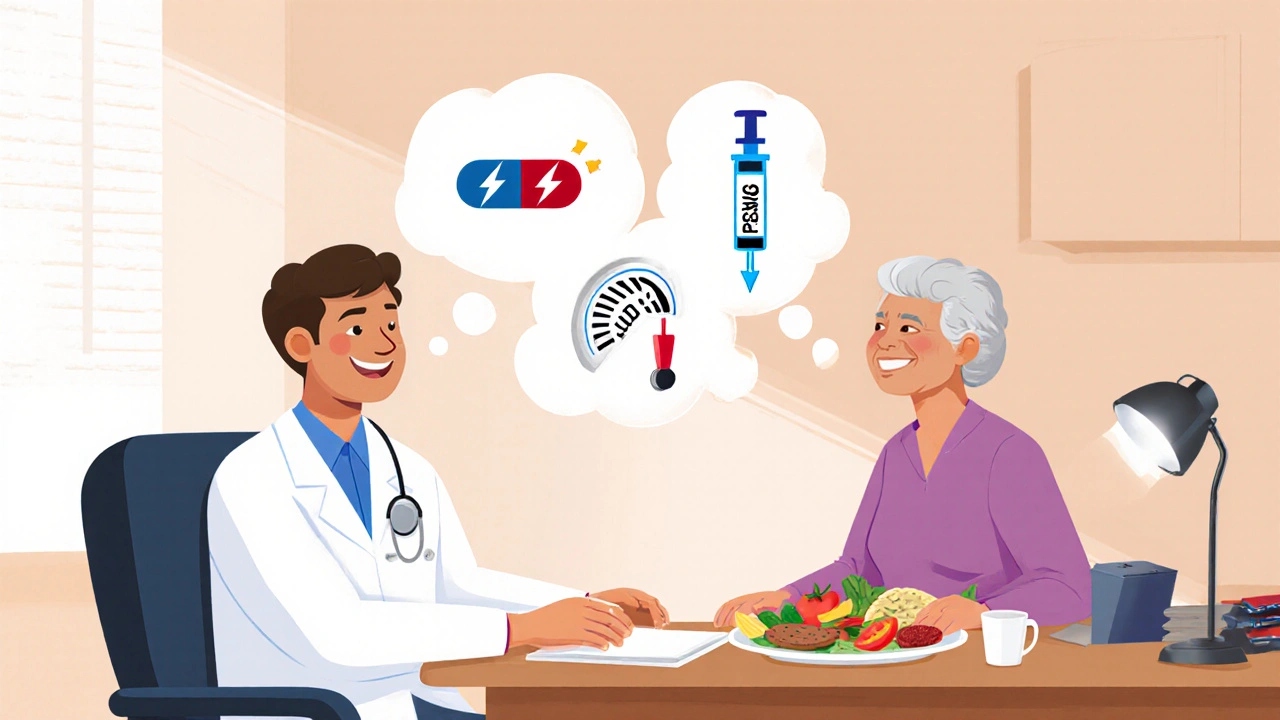Crestor (Rosuvastatin) vs Other Cholesterol Drugs: Benefits, Risks & Top Alternatives
 Oct, 21 2025
Oct, 21 2025
Cholesterol Drug Selector Tool
Personalize Your Medication Selection
Trying to decide whether Crestor is the right cholesterol pill for you? You’re not alone. Millions juggle dozens of options, from classic statins to newer injectable therapies. This guide breaks down Crestor (rosuvastatin) side‑by‑side with the most common alternatives, so you can match the drug to your health goals, budget, and lifestyle.
What is Crestor (Rosuvastatin)?
Crestor (Rosuvastatin) is a synthetic HMG‑CoA reductase inhibitor, commonly called a statin, that lowers low‑density lipoprotein (LDL) cholesterol by blocking the enzyme responsible for cholesterol production in the liver. Approved by the FDA in 2003, it’s one of the most potent statins on the market, often prescribed when patients need a big drop in LDL or when other statins haven’t delivered enough reduction.
How Crestor Works
By inhibiting HMG‑CoA reductase, Crestor reduces the liver’s ability to synthesize cholesterol. The liver then pulls more LDL out of the bloodstream to meet its needs, which drops the circulating LDL level. Typical dose ranges from 5 mg to 40 mg once daily, with higher doses achieving up to a 60 % reduction in LDL.
Key Benefits of Crestor
- High potency - often lowers LDL more than other statins at comparable doses.
- Once‑daily dosing, usually with or without food.
- Works well in patients with diabetes or metabolic syndrome.
- Proven to reduce cardiovascular events in large trials like JUPITER.
Common Alternatives to Crestor
Below are the most frequently considered options when a doctor or patient looks for something other than Crestor.
Atorvastatin is a widely used statin that offers strong LDL‑lowering effects with a flexible dosing range of 10 mg to 80 mg. It’s often the first‑line choice because it’s inexpensive and generic.
Simvastatin is a moderate‑potency statin typically prescribed at 10 mg to 40 mg daily. Its main appeal is a long history of use and low cost.
Pravastatin is a low‑potency statin favored for patients who experience muscle side effects with stronger statins. Doses range from 10 mg to 40 mg.
Ezetimibe works a different way - it blocks cholesterol absorption in the intestines. It’s often paired with a statin or used alone when statins aren’t tolerated.
PCSK9 inhibitors are injectable monoclonal antibodies that dramatically cut LDL by up to 70 % by preventing the PCSK9 protein from destroying LDL receptors. Two FDA‑approved options are listed below.
Evolocumab is a PCSK9 inhibitor given subcutaneously every 2‑4 weeks, often reserved for high‑risk patients or those with familial hypercholesterolemia.
Alirocumab is another PCSK9 inhibitor with a similar dosing schedule, approved for patients who need additional LDL reduction beyond statins.

Side‑Effect Profiles Compared
All cholesterol‑lowering drugs carry some risk. Here’s a quick look at the most common adverse events:
- Crestor: muscle pain (myalgia) in ~5‑10 % of users, rare liver enzyme elevation, possible diabetes risk.
- Atorvastatin: similar muscle risk, slightly higher rates of elevated liver enzymes.
- Simvastatin: higher chance of drug interactions (especially with CYP3A4 inhibitors).
- Pravastatin: lowest muscle‑related side‑effect rate among statins.
- Ezetimibe: mostly gastrointestinal upset; very low muscle risk.
- PCSK9 inhibitors: injection site reactions, flu‑like symptoms; almost no muscle issues.
Cost Considerations
Price often decides the final choice. Below is an average monthly cost in the United States (as of 2025), not accounting for insurance discounts.
| Drug | Typical Dose | LDL Reduction % | Average Cost | Key Side‑Effects |
|---|---|---|---|---|
| Crestor (Rosuvastatin) | 10‑20 mg | 45‑55 | $25‑35 | Myalgia, liver enzymes |
| Atorvastatin | 10‑80 mg | 35‑50 | $10‑20 | Myalgia, liver enzymes |
| Simvastatin | 20‑40 mg | 30‑45 | $8‑15 | Myalgia, drug interactions |
| Pravastatin | 10‑40 mg | 20‑35 | $6‑12 | Low muscle risk |
| Ezetimibe | 10 mg | 15‑20 (alone) | $40‑45 | GI upset |
| Evolocumab | 140 mg q2‑4wks | 60‑70 | $1,400‑1,800 | Injection site, flu‑like |
| Alirocumab | 75‑150 mg q2‑4wks | 55‑65 | $1,200‑1,600 | Injection site, flu‑like |
How to Choose the Right Drug
Think of the decision as a checklist. Consider each factor and see where Crestor lands.
- LDL‑lowering goal: If you need a >50 % drop, Crestor, high‑dose Atorvastatin, or a PCSK9 inhibitor are the top picks.
- Risk of muscle side effects: Patients with a history of myalgia might start with Pravastatin or Ezetimibe before trying Crestor.
- Drug interactions: Crestor has fewer CYP450 interactions than Simvastatin, making it safer with many antibiotics or antifungals.
- Cost & insurance coverage: If out‑of‑pocket expense is a concern, generic Atorvastatin or Simvastatin usually win.
- Special conditions: For familial hypercholesterolemia or those who haven’t hit targets on maximal statins, PCSK9 inhibitors become cost‑effective despite higher price.

Pros and Cons of Crestor at a Glance
| Pros | Cons |
|---|---|
| High potency, works at low doses | Higher risk of myopathy compared to low‑potency statins |
| Fewer drug‑interaction concerns | Potential increase in blood sugar for diabetics |
| Proven cardiovascular outcome data | Cost slightly above generic statins |
Real‑World Scenarios
Scenario 1 - High‑risk heart patient: A 58‑year‑old with prior heart attack needs an LDL drop to under 70 mg/dL. Crestor 20 mg plus low‑dose Ezetimibe hits the target faster than Atorvastatin alone, while staying oral.
Scenario 2 - Statin‑intolerant senior: A 72‑year‑old experiences muscle aches on any statin. Starting Pravastatin 10 mg failed, but switching to Ezetimibe + low‑dose Crestor (5 mg) eliminated pain and still lowered LDL by ~20 %.
Scenario 3 - Family hypercholesterolemia: A 30‑year‑old with LDL > 190 mg/dL despite maximally‑tolerated Atorvastatin 80 mg. Adding Evolocumab brought LDL down to 70 mg/dL, achieving guideline goals.
Tips to Maximize Benefits and Minimize Risks
- Take Crestor at the same time each day; evening dosing works for most people.
- Check liver enzymes before starting and repeat after 6‑12 weeks.
- If muscle pain appears, ask your doctor about a temporary pause or dose reduction before stopping outright.
- Combine with lifestyle changes-diet low in saturated fat, regular aerobic exercise-to boost LDL reduction by an extra 5‑10 %.
- Review all current meds with your pharmacist; Crestor can interact with certain anticoagulants and HIV protease inhibitors.
Frequently Asked Questions
Can I switch from another statin to Crestor safely?
Yes. Most doctors start you on a low dose (5 mg) and monitor liver enzymes and muscle symptoms for a few weeks before adjusting. A gradual switch reduces the chance of side effects.
Is Crestor safe during pregnancy?
Statins, including Crestor, are classified as Category X - they can cause birth defects. Women who are pregnant or planning a pregnancy should avoid all statins and discuss alternatives with their provider.
How does Crestor compare to PCSK9 inhibitors for heart‑failure patients?
PCSK9 inhibitors deliver a larger LDL drop (up to 70 %) and are injectable, making them ideal for patients who cannot tolerate any oral statin. Crestor is oral and cheaper, but may not reach the aggressive targets needed for some heart‑failure cases.
Will Crestor raise my blood sugar?
A small increase in fasting glucose has been observed in about 0.5‑1 % of users, especially those already predisposed to diabetes. Regular monitoring is advised.
Is it worth taking a cheap generic statin instead of Crestor?
If your LDL goal is modest (e.g., 100‑130 mg/dL) and you tolerate other statins well, a generic like Atorvastatin is cost‑effective. For high‑risk patients needing a larger swing, Crestor’s potency can save you a second medication.
Choosing the right cholesterol‑lowering therapy isn’t a one‑size‑fits‑all decision. By weighing potency, side‑effect risk, cost, and personal health factors, you can match the drug to your needs. Whether you stay on Crestor, switch to another statin, add Ezetimibe, or consider a PCSK9 inhibitor, the goal stays the same: protect your heart and stay healthy.
Angela Koulouris
October 21, 2025 AT 16:23If you're weighing Crestor against the other options, start by mapping your LDL goal to the potency you need. Crestor’s high potency can shave off a big chunk of LDL with a modest dose, which is great for folks who need that extra push. Keep an eye on muscle aches, though-if they creep in, a dose tweak or a switch to a gentler statin might be the answer. Pairing the drug with a heart‑healthy diet and regular walks will amplify the benefits.
Harry Bhullar
November 2, 2025 AT 11:40The cholesterol landscape has evolved dramatically over the past two decades, and Crestor sits near the top of the potency hierarchy among oral statins. Its mechanism, a tight binding to HMG‑CoA reductase, translates into LDL reductions that often exceed 50 % in high‑dose regimens. When you compare that to a generic Atorvastatin 80 mg, the dose‑response curve shows Crestor achieving similar drops at roughly a quarter of the milligram amount. That efficiency can be a lifesaver for patients who struggle with polypharmacy, because fewer tablets mean fewer opportunities for drug‑drug interactions. Speaking of interactions, Crestor is metabolized primarily via CYP2C9 rather than the CYP3A4 pathway, which reduces the risk of antagonism with common antibiotics and antifungals. However, it does have a modest interaction profile with certain anticoagulants, so checking INR more frequently when you start or stop the drug is prudent. The side‑effect profile mirrors that of other high‑potency statins: myalgia in about 5‑10 % of users, occasional elevations in transaminases, and a small uptick in new‑onset diabetes in susceptible individuals. In the JUPITER trial, patients with elevated CRP who were on Crestor experienced a statistically significant reduction in major cardiovascular events compared with placebo, reinforcing the outcome data that many clinicians rely on. Cost‑wise, Crestor sits a bit higher than generic Atorvastatin but remains far cheaper than the injectable PCSK9 inhibitors, which can exceed $1,500 per month. Insurance formularies often place Crestor in a Tier 2 position, meaning copays are usually manageable, especially with manufacturer coupons. For patients with familial hypercholesterolemia who have exhausted the maximal tolerated dose of a statin, adding a PCSK9 inhibitor on top of Crestor can push LDL into the sub‑70 mg/dL range, which is often the guideline target. Lifestyle interventions are not optional; a Mediterranean‑style diet, 150 minutes of moderate aerobic activity per week, and smoking cessation can each contribute an additional 5‑10 % LDL reduction, synergizing nicely with the drug’s effect. Monitoring should include a baseline liver panel, followed by a repeat at 6‑12 weeks, and periodic CK checks if the patient reports any muscle tenderness. If muscle symptoms arise, consider a temporary de‑challenge, dose reduction, or a switch to a lower‑potency statin like Pravastatin before abandoning statin therapy altogether. Ultimately, the choice between Crestor and its alternatives hinges on three pillars: the magnitude of LDL reduction required, the patient’s tolerance profile, and the economic context. By weighing these factors together, you can arrive at a personalized regimen that maximizes cardiovascular protection while minimizing unwanted side effects.
Ashok Kumar
November 14, 2025 AT 07:56So you’ve read the whole guide and still can’t decide? Well, congratulations on mastering the art of analysis paralysis. If you’re allergic to myalgia, maybe stick to Pravastatin and call it a day.
Jasmina Redzepovic
November 26, 2025 AT 04:13From a pharmacoeconomic standpoint, Crestor epitomizes the inefficiency of the American drug pricing model; we’re essentially paying premium for a molecule that could be synthesized domestically at a fraction of the cost. The FDA’s approval pipeline, while rigorous, often masks the geopolitical leverage exerted by Big Pharma, which uses patents to stifle competition. Moreover, the LDL‑centric paradigm ignores the nuanced role of HDL and triglycerides, leading clinicians to overprescribe high‑intensity statins without addressing the root dietary causes. In terms of pharmacodynamics, the drug’s high affinity for HMG‑CoA reductase translates into a steep dose‑response curve, but that also means a narrower therapeutic window for patients with hepatic insufficiency. Clinical guidelines from societies heavily funded by the industry tend to favor Crestor for “high‑risk” patients, reinforcing a cycle of dependency on costly medication rather than preventive public health measures. Bottom line: unless you have a clear, guideline‑based indication, opting for a generic statin or a lifestyle overhaul is both fiscally responsible and medically sound.
Esther Olabisi
December 8, 2025 AT 00:30Wow, your drug‑shopping saga sounds like a Netflix binge 🍿. Remember, a smile and a salad can do wonders 😅.
Ivan Laney
December 19, 2025 AT 20:46Listen, the notion that a handful of greens can replace a clinically validated LDL‑lowering agent is pure mythology propagated by pseudo‑health influencers. The pharmacokinetic profile of a statin like Crestor is backed by decades of randomized controlled trials, whereas dietary changes, while beneficial, lack the potency to achieve sub‑70 mg/dL targets in high‑risk cohorts. If you’re serious about cardiovascular protection, you must prioritize evidence‑based therapy over feel‑good anecdotes. Moreover, insurance reimbursements often subsidize statins precisely because they are cost‑effective at a population level, a fact you’d be wise to acknowledge. In short, don’t let optimism replace prescription.